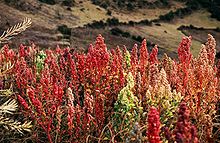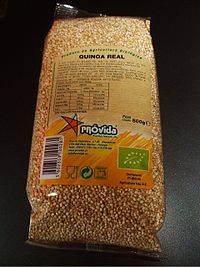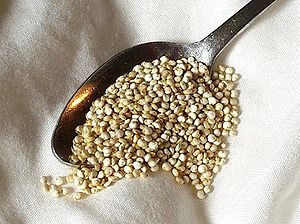- Quinoa
-
This article is about the grain-like crop from South America. For the town with a similar name, see Quinua, Peru. For the 1992 album by Tangerine Dream, see Quinoa (album).
Quinoa Scientific classification Kingdom: Plantae (unranked): Angiosperms (unranked): Eudicots (unranked): Core eudicots Order: Caryophyllales Family: Amaranthaceae Subfamily: Chenopodioideae Genus: Chenopodium Species: C. quinoa Binomial name Chenopodium quinoa
Willd.Quinoa (
 /ˈkiːnwɑː/ or /kɨˈnoʊ.ə/, Spanish: quinua, from Quechua: kinwa), a species of goosefoot (Chenopodium), is a grain-like crop grown primarily for its edible seeds. It is a pseudocereal rather than a true cereal, or grain, as it is not a member of the grass family. As a chenopod, quinoa is closely related to species such as beets, spinach, and tumbleweeds.
/ˈkiːnwɑː/ or /kɨˈnoʊ.ə/, Spanish: quinua, from Quechua: kinwa), a species of goosefoot (Chenopodium), is a grain-like crop grown primarily for its edible seeds. It is a pseudocereal rather than a true cereal, or grain, as it is not a member of the grass family. As a chenopod, quinoa is closely related to species such as beets, spinach, and tumbleweeds.Contents
Overview
Derived from the Spanish spelling of the Quechua name kinwa or occasionally "Qin-wah", Quinoa originated in the Andean region of Ecuador, Bolivia, Colombia and Peru before they were colonized and became nation-states, where it was successfully domesticated 3000 to 4000 years ago for human consumption, though archeological evidence shows a non-domesticated association with pastoral herding some 5200 to 7000 years ago.[1]
Similar Chenopodium species, such as pitseed goosefoot (Chenopodium berlandieri) and fat hen (Chenopodium album), were grown and domesticated in North America as part of the Eastern Agricultural Complex before maize agriculture became popular.[2] Fat hen, which has a widespread distribution in the Northern Hemisphere, produces edible seeds and greens much like quinoa, but in smaller quantities.
The nutrient composition is very good compared with common cereals. Quinoa grains contain essential amino acids like lysine and good quantities of calcium, phosphorus, and iron.[3]
After harvest, the grains need to be processed to remove the coating containing the bitter-tasting saponins. Quinoa grains are in general cooked the same way as rice and can be used in a wide range of dishes. Quinoa leaves are also eaten as a leaf vegetable, much like amaranth, but the commercial availability of quinoa greens is limited.
Natural distribution
Chenopodium quinoa (and a related species from Mexico, Chenopodium nuttalliae) is believed to have been domesticated in the Peruvian Andes from wild populations of Chenopodium quinoa.[4] There are non-cultivated quinoa plants (Chenopodium quinoa var. melanospermum), which grow in the same area where it is cultivated; it is presumed that those are related to quinoa's wild predecessors, but they could instead be descendants of cultivated plants.[5]
History and culture
The Incas, who held the crop to be sacred,[6] referred to quinoa as chisaya mama or 'mother of all grains', and it was the Inca emperor who would traditionally sow the first seeds of the season using 'golden implements'.[6] During the European conquest of South America, the Spanish colonists scorned quinoa as 'food for Indians',[7] and even actively suppressed its cultivation, due to its status within indigenous non-Christian ceremonies.[8] In fact, the conquistadores forbade quinoa cultivation for a time[9] and the Incas were forced to grow wheat instead.[10]
Biology
Quinoa is a dicotyledonous, annual plant usually about 1–2 m high. It has broad, generally pubescent, powdery, smooth (rarely) to lobed leafs normally arranged alternately. The woody central stem is either branched or unbranched depending on the variety and may be green, red or purple. The panicles arise either from the top of the plant or from axils on the stem. The panicles have a central axis from which a secondary axis emerges either with flowers (amaranthiform), or bearing a tertiary axis carrying the flowers (glomeruliform).[11] The green, hypogynous flowers have a simple perianth and are generally bisexual and self-fertilizing.[11][12] The fruits are about 2 mm in diameter and of various colours — from white to red or black depending on the cultivar.[3]
Cultivation
Climate requirements
Quinoa is highly variable due to a high complexity of different subspecies, varieties and landraces. However, in general it is undemanding and altitude-hardy. It is grown from coastal regions (Chile) to over 4000 m (13,120 ft) in the Andes near the equator. However, most of the cultivars are grown between 2500 m and 4000 m. Depending on the variety, Quinoa's optimal growing conditions are in cool climates with temperatures that range from 25°F/−3°C, during the night, to below 95°F/35°C, during the day. Some cultivars can also withstand lower temperatures without damage. Light frosts normally don’t affect the plants at any stage of development except during flowering. Mid-summer frosts often occurring in the Andes during flowering led to sterilization of the pollen. Rainfall conditions are highly variable between the different cultivars, ranging from 300 to 1000 mm during growing season. Optimal for Quinoa growth is well-distributed rainfall during early growth and development and dry conditions during seed maturation and harvesting.[11]
Soil requirements
Quinoa does best in sandy, well-drained soils with a low nutrient content, moderate salinity, and a soil pH of 6 to 8.5.
Agronomy
Sowing
World Quinoa Production – 2009
(thousand metric ton) Peru
Peru40.0  Bolivia
Bolivia28.3  Ecuador
Ecuador0.7 World Total 69.0 Source: UN Food & Agriculture Organisation (FAO) Current figures from FAO The seedbed must be well prepared and drained to avoid waterlogging. Normally in the Andes, Quinoa seeds are broadcast over land and raked into the soil. Sometimes it is sown in narrow, shallow soils.
Cultivation management
Yields are maximised when 150 to 180 lbs N/acre are available. The addition of phosphorus does not improve yield. In eastern North America, it is susceptible to a leaf miner that may reduce crop success; this leaf miner also affects the common weed and close relative Chenopodium album, but C. album is much more resistant.
Harvesting and handling
Harvesting is usually up until now mainly done by hand and rarely by machine, because of the extremely variable periods of maturity of native Quinoas, which increases difficulty of mechanization. So, an exact timing of harvest is important in order to avoid a high loss of grains due to shattering. However, the exact harvesting time is difficult to determine because panicles of the same plant mature at different times. The grain yield reaches comparable dimensions (often around 3 t/ha up to 5 t/ha) to wheat yields in the Andean areas. Handling involves threshing the seedheads and winnowing the seed to remove the husk. Before storage, the seeds need to be dried in order to avoid germination.[11]
Nutritional value
Quinoa, uncooked Nutritional value per 100 g (3.5 oz) Energy 1,539 kJ (368 kcal) Carbohydrates 64 g - Starch 52 g - Dietary fibre 7 g Fat 6 g - polyunsaturated 3.3 g Protein 14 g Water 13 g Thiamine (vit. B1) 0.36 mg (31%) Riboflavin (vit. B2) 0.32 mg (27%) Vitamin B6 0.5 mg (38%) Folate (vit. B9) 184 μg (46%) Vitamin E 2.4 mg (16%) Iron 4.6 mg (35%) Magnesium 197 mg (55%) Phosphorus 457 mg (65%) Zinc 3.1 mg (33%) Percentages are relative to US recommendations for adults.
Source: USDA Nutrient DatabaseQuinoa was of great nutritional importance in pre-Columbian Andean civilizations, secondary only to the potato, and was followed in importance by maize. In contemporary times, this crop has become highly appreciated for its nutritional value, as its protein content is very high (12%–18%). Unlike wheat or rice (which are low in lysine), and like oats, quinoa contains a balanced set of essential amino acids for humans, making it a complete protein source, unusual among plant foods.[13] It is a good source of dietary fiber and phosphorus and is high in magnesium and iron. Quinoa is gluten-free and considered easy to digest. Because of all these characteristics, quinoa is being considered a possible crop in NASA's Controlled Ecological Life Support System for long-duration manned spaceflights.[13]
Saponin content
Quinoa in its natural state has a coating of bitter-tasting saponins, making it unpalatable. Most quinoa sold commercially in North America has been processed to remove this coating. This bitterness has beneficial effects during cultivation, as the plant is unpopular with birds and thus requires minimal protection.[14] There have been attempts to lower the saponin content of Quinoa through selective breeding to produce sweeter, more palatable varieties that have proven difficult due to cross pollination contamination.[15]
The toxicity category rating of Quinoa saponins are classified as a mild eye and respiratory irritant and a low gastrointestinal irritant.[16] The saponin is a toxic glycoside, a main contributor to its hemolytic effects when combined directly with blood cells. In South America, Quinoa saponin has many uses outside of consumption, which includes detergent for clothing and washing, and as an antiseptic for skin injuries.[17] High levels of oxalic acid in the leaves and stems are found in all species of the Chenopodium genus, but are also present in the related plant families of Polygonaceae and Amaranthaceae.[18] The risks associated with quinoa are minimal, provided it is properly prepared and leaves are not eaten to excess.
Preparation
Quinoa has a light, fluffy texture when cooked, and its mild, slightly nutty flavor makes it an alternative to white rice or couscous.
Most boxed/pre-packaged quinoa has already been pre-rinsed for convenience, and cooking instructions therefore suggest only a brief rinse before cooking, if at all. If quinoa has not been pre-rinsed, the first step is to remove the saponins, a process that requires either soaking the grain in water for a few hours, then changing the water and resoaking, or rinsing the quinoa in ample running water for several minutes in either a fine strainer or a cheesecloth. Removal of the saponin helps with digestion; the soapy nature of the compound makes it act as a laxative.
One cooking method is to treat quinoa much like rice, bringing two cups (or less) of water to a boil with one cup of grain, covering at a low simmer and cooking for 10–15 minutes or until the germ separates from the seed. The cooked germ looks like a tiny curl and should have a slight bite to it (like al dente pasta). As an alternative, one can use a rice cooker to prepare quinoa, treating it just like white rice (for both cooking cycle and water amounts).
Vegetables and seasonings can also be added to make a wide range of dishes. Chicken or vegetable stock can be substituted for water during cooking, adding flavor. It is also suited to vegetable pilafs, complementing bitter greens like kale.
Quinoa can serve as a high-protein breakfast food mixed with honey, almonds, or berries; it is also sold as a dry product, much like corn flakes. Quinoa flour can be used in wheat-based and gluten-free baking.
Quinoa may be germinated in its raw form to boost its nutritional value. Germination activates its natural enzymes and multiplies its vitamin content.[19] In fact, quinoa has a notably short germination period: Only 2–4 hours resting in a glass of clean water is enough to make it sprout and release gases, as opposed to, e.g., 12 hours with wheat.[citation needed] This process, besides its nutritional enhancements, softens the grains, making them suitable to be added to salads and other cold foods.
Name
This crop is known as quinoa in English and, according to Merriam–Webster, the primary pronunciation is with two syllables with the accent on the first (
 /ˈkiːnwɑː/ keen-wah).[20] It may also be pronounced with three syllables, with the stress on either the first syllable (
/ˈkiːnwɑː/ keen-wah).[20] It may also be pronounced with three syllables, with the stress on either the first syllable ( /ˈkiːnoʊ.ə/ kee-noh-ə) or on the second (
/ˈkiːnoʊ.ə/ kee-noh-ə) or on the second ( /kwɨˈnoʊ.ə/ kwi-noh-ə). In Spanish, the spelling and pronunciation vary by region. The accent may be on the first syllable, in which case it is usually spelled quinua [ˈkinwa], with quínoa [ˈkinoa] being a variant; or on the second syllable: [kiˈnoa]), in which case it is spelled quinoa. The name derives from the Quechua kinwa, pronounced in the standard dialect [ˈkinwa]. There are multiple other native names in South America:
/kwɨˈnoʊ.ə/ kwi-noh-ə). In Spanish, the spelling and pronunciation vary by region. The accent may be on the first syllable, in which case it is usually spelled quinua [ˈkinwa], with quínoa [ˈkinoa] being a variant; or on the second syllable: [kiˈnoa]), in which case it is spelled quinoa. The name derives from the Quechua kinwa, pronounced in the standard dialect [ˈkinwa]. There are multiple other native names in South America:- Quechua: ayara, kiuna, kuchikinwa, achita, kinua, kinoa, chisaya mama
- Aymara: supha, jopa, jupha, juira, ära, qallapi, vocali
- Chibchan: Suba, pasca
- Mapudungun: dawe, sawe
See also
References
- ^ Kolata, Alan L. (2009). "Quinoa". Quinoa: Production, Consumption and Social Value in Historical Context. Department of Anthropology, The University of Chicago. http://lasa.international.pitt.edu/members/congress-papers/lasa2009/files/KolataAlanL.pdf.
- ^ Smith, Bruce 1999 "The Emergence of Agriculture", W H Freeman & Co., New York. ISBN 0716760304}
- ^ a b J. G. Vaughn & C. A. Geissler (2009). The new Oxford book of food plants. Oxford University Press.
- ^ Barbara Pickersgill (August 31, 2007). "Domestication of Plants in the Americas: Insights from Mendelian and Molecular Genetics". Annals of Botany 100 (5): 925–40. doi:10.1093/aob/mcm193. PMC 2759216. PMID 17766847. http://aob.oxfordjournals.org/cgi/content/full/mcm193v1.
- ^ Charles B. Heiser Jr. and David C. Nelson (September 1974). "On the Origin of the Cultivated Chenopods (Chenopodium)". Genetics 78 (1): 503–5. PMC 1213209. PMID 4442716. http://www.genetics.org/cgi/content/abstract/78/1/503.
- ^ a b Popenoe, Hugh (1989). Lost crops of the Incas: little-known plants of the Andes with promise for worldwide cultivation. Washington, D.C.: National Academy Press. p. 149. ISBN 0-309-04264-X. http://books.google.com/?id=jMlxpytjZq0C&printsec=frontcover&dq=Lost+crops+of+the+Incas#v=onepage&q=quinoa&f=false.
- ^ Gade, Daniel W. (1999). Nature and culture in the Andes. Madison: University of Wisconsin Press. p. 206. ISBN 0-299-16124-2.
- ^ Bailey, Garrick Alan; Peoples, James (2009). Humanity: an introduction to cultural anthropology. Belmont, CA: Wadsworth Cengage Learning. p. 120. ISBN 0-495-50874-8.
- ^ Bernice Kagan; Meredith McCarty (1995). Fresh from a vegetarian kitchen. New York: St. Martin's Press. p. 56. ISBN 0-312-11795-7.
- ^ Andy Turnbull (2005). We need to talk: about the future of Canada. Toronto: Red Ear Pub. p. 23. ISBN 0-9681258-5-9.
- ^ a b c d Research Coun National Research Council (2005). The Lost Crops of the Incas: Little-Known Plants of the Andes with Promise for Worldwide Cultivation. http://www.amazon.com/dp/0894991973.
- ^ Reinhard Lieberei, Christoph Reissdorff & Wolfgang Franke (2007). Nutzpflanzenkunde. Georg Thieme Verlag. http://www.amazon.de/dp/3135304078.
- ^ a b Greg Schlick and David L. Bubenheim (November 1993). "Quinoa: An Emerging "New" Crop with Potential for CELSS" (PDF). NASA Technical Paper 3422. NASA. http://ntrs.nasa.gov/archive/nasa/casi.ntrs.nasa.gov/19940015664_1994015664.pdf.
- ^ "Quinoa". Alternative Field Crops Manual. University of Wisconsin Extension and University of Minnesota. January 20, 2000. http://www.hort.purdue.edu/NEWCROP/AFCM/quinoa.html.
- ^ Masterbroek, H.D.; Limburg, H., Gilles, T. and Marvin, H. J. (2000). Occurrence of sapogenins in leaves and seeds of Quinoa (Chenopodium quinoa Willd).. New York, NY.: Journal of the Science of Food and Agriculture. pp. 152–156. doi:10.1002/(SICI)1097-0010(20000101)80:1<152::AID-JSFA503>3.0.CO;2-P.
- ^ "Quinoa". EPA. 2009. http://www.epa.gov/oppbppd1/biopesticides/ingredients/tech_docs/brad_097094.pdf.
- ^ "Quinoa". Issues in New Crops and New Uses Proceedings of the sixth National Symposium Creating Markets for Economic Development of New Crops and New Uses, Duane L. Johnson and Sarah M. Ward, 1993. Quinoa. p. 219–221. In: J. Janick and J.E. Simon (eds.), New crops. Wiley, New York.. the Center for New Crops & Plant Products, Purdue University. 1993. http://www.hort.purdue.edu/newcrop/proceedings1993/v2-222.html. Retrieved April 11, 1997.
- ^ Siener, Roswitha; Ruth Honow, Ana Seidler, Susanne Voss, Albrecht Hesse (2006). Oxalate contents of species of the Polygonaceae, Amaranthaceae and Chenopodiaceae families. Food Chemistry, Volume 98 Issue 2. pp. 220–224. doi:10.1016/j.foodchem.2005.05.059.. ISSN 0308-8146. http://www.sciencedirect.com/science/article/B6T6R-4GRH7CB-8/2/1d4d300198a06a524425ccd18eb547de).
- ^ Deep Nutrition: Why Your Genes Need Traditional Foods, Catherine Shanahan, MD, Luke Shanahan (2008) pp. 148–151
- ^ "Merriam–Webster Dictionary, quinoa". Merriam-webster.com. 2010-08-13. http://www.merriam-webster.com/dictionary/quinoa. Retrieved 2011-03-21.
External links
- Quinoa at the Open Directory Project
- The New York Times, article, march 2011: Quinoa’s Global Success Creates Quandary at Home
- The New York Times, Recipes for Health: Quinoa
- Quinoa Gluten Free Gluten Free Quinoa
Cereals and pseudocereals Amaranth · Amaranthus caudatus · Amaranthus cruentus · Amaranthus hypochondriacus · Barley · Buckwheat · Chia · Fonio · Job's Tears · Kañiwa · Maize (corn) · Millet · Oat · Pitseed Goosefoot · Quinoa · Rice · Rye · Sorghum · Spelt · Teff · Triticale · Wheat · Wild rice
Crop wild relativeCategories:- Chenopodium
- Flora of South America
- Grains
- Leaf vegetables
- Quechua loanwords
- Tropical agriculture
- Staple foods
- Edible nuts and seeds
- Crops originating from the Americas
- Crops originating from Ecuador
- Crops originating from Peru
Wikimedia Foundation. 2010.









